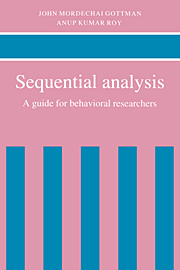Book contents
- Frontmatter
- Contents
- Preface
- Reading this book quickly
- Part I Introduction
- Part II Fitting the timetable
- Part III The timetable and the contextual design
- Chapter 10 Log-linear models
- Chapter 11 Log-linear models: review and examples
- Chapter 12 A single case analysis of the timetable
- Chapter 13 Logit models and logistic regression
- Chapter 14 The problem of autocontingency and its solutions
- Chapter 15 Recent advances: a brief overview
- Chapter 16 A brief summary
- References
- Index
Chapter 10 - Log-linear models
from Part III - The timetable and the contextual design
Published online by Cambridge University Press: 10 November 2009
- Frontmatter
- Contents
- Preface
- Reading this book quickly
- Part I Introduction
- Part II Fitting the timetable
- Part III The timetable and the contextual design
- Chapter 10 Log-linear models
- Chapter 11 Log-linear models: review and examples
- Chapter 12 A single case analysis of the timetable
- Chapter 13 Logit models and logistic regression
- Chapter 14 The problem of autocontingency and its solutions
- Chapter 15 Recent advances: a brief overview
- Chapter 16 A brief summary
- References
- Index
Summary
It is not enough to be able to say that the order of sequential dependency is two or three, or even that there is some temporal structure in the data. In most of our research we have an experimental design and want to know if specific sequential patterns vary with our experimental factors. For example, suppose we have studied younger and older children and observed interactions of pairs of children either with their best friends or with strangers. We may want to know if friends are more likely than strangers to clarify their message in response to a clarification request. This is the kind of question sequential analysis is designed for.
Log-linear analysis is the generalization of analysis of variance to contingency tables in which the entries in each cell are counts, sampled under some distributional assumption. The typical case of interest to us is one in which we have some experimental design (which we call the contextual design) and in each cell of this design we have a timetable. The timetable has been constructed to be of a particular order based on our order and stationarity tests. It has also been based on pooling data across subjects (dyads, families, groups, etc.) based on our homogeneity tests. We now want to know how particular cells in the timetable that are of theoretical interest vary as a function of main effects and interaction effects in the contextual design. Such questions can be answered with log-linear models.
Information
- Type
- Chapter
- Information
- Sequential AnalysisA Guide for Behavorial Researchers, pp. 113 - 132Publisher: Cambridge University PressPrint publication year: 1990
